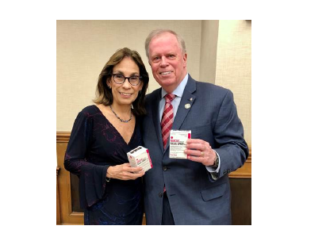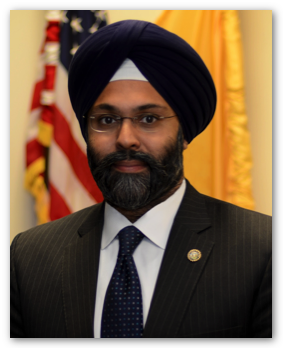
NORWOOD, N.J.—We often have trouble putting names to faces. But for too many victims of opioid addiction and overdoses, the faces have names—names we should never forget.
For middle-schoolers attending a recent presentation by two recovering addicts at Norwood Public School, they not only heard from two “live” been-there-done-that addicts now in recovery, but also saw up-close and personal photos of 10 young adults who died from their addictions.
The photos of the 10 overdose victims lined the raised stage behind the two speakers.
The backdrop of photos on large, poster-size display boards was striking: One was a football player, one was a baseball player, six were young men and four were young women.
All were brothers and sisters, sons and daughters, maybe even aunts and uncles.
All looked happy, engaged, many were smiling and except for two dates—marked by a dash beneath each name—they looked just like all the teenagers in the room that day.
While the speakers—Melissa Davies, 23, of Waldwick, and Jordan Braunstein, 30, of Englewood—talked of their own personal experiences with drugs and how they were able to get into recovery, the 10 faces of deceased young adults behind them told another story of pain, heartache and loss.
Last year in New Jersey, there were 3,163 victims of opioid overdoses—many nameless and faceless victims except to family and friends—who lost their lives to addiction.

‘Preventable’ disease
But there’s a group in Bergen County, a group of recovering young drug and alcohol addicts and parents of overdose victims that is speaking out in hopes of reaching young adults before they wind up as victims of a preventable disease.
“It’s an epidemic in our nation,” said Nancy Labov, of Old Tappan, founder of Alumni In Recovery, a five-year-old not-for-profit volunteer organization of young adults and parents, who speak to middle schools and high schools—and parents of students—about the costs of addiction, how to seek help, and resources available.
The group has come together to provide 80 presentations so far in 2019 to middle-school and high school students across Bergen County, and will soon expand beyond Bergen schools, said Labov. That includes an upcoming program at Charles DeWolf Middle School in Old Tappan on Thursday, Oct. 10 at 7:30 p.m.
The group hopes to show young adults, parents and involved adults that by ending the stigma around the disease of addiction, they can provide an accepting environment to encourage young adults to come forward and seek the help they need.
Labov said peer-to-peer personal communication from recovering young adults is crucial to reaching teens heading down a path to addiction, abuse and overdosing.
Talking ‘peer-to-peer’
“The peer-to-peer approach is how people get hope. They see there is a path that allows them to say, ‘Hey, they’re like me. I can get better, too, and do something with my life,’” said Labov.
At the recent Norwood Public School presentation, Dee Gillen, of Haworth, mother of Scott Gillen, displayed a photo of her son playing football.
Scott died at age 27 from a drug overdose. Gillen, a member of AinR’s parents’ group, has helped parents who have lost sons and daughters by creating posters to memorialize them, which serve as a remembrance and a reminder of the cost of addiction.
Jordan’s opioid abuse
Jordan relived an experience that showed the difference between someone who might be prone to addiction versus not.
He said when he was with a friend as an underage teenager, the friend’s grandfather offered them both a taste of whiskey.
Later that night, the boys consumed the entire bottle of whiskey, both waking up to vomiting and headaches. He said whereas his friend said he’d never do it again, Jordan said he couldn’t wait to do it again.
But like so many before him, it was a painkiller—an opioid—prescribed for a sports injury that put him on the road to further drug abuse, and an endless cycle of cocaine use that landed him in trouble with the law when he was 18.
He said the oxycodone prescription he was given after he dislocated his shoulder while boxing made him feel great, feeling no pain, no insecurities and no fears. Unfortunately, when his doctor ended the prescription he began what he called “a scary cycle” of opioid withdrawal.
It took the overdose death of a best friend to finally motivate him to get off drugs, he said.
“I tried to get clean so many times,” said Jordan at one point.
“You have options, you have choices…to reach out,” he added, noting teens should help each other and suggested middle and high school students need to be more inclusive and supportive.
“If we were just nicer to each other in general,” he said.
‘Turn epidemic around’
“It’s a preventable disease; it’s a brain disease,” said Labov of addiction. “Speaking openly about the disease of addiction can allow us to recover… We are finding ways for people to become proactive to turn this epidemic around,” she added.
Labov said her experience as a nurse in addiction and psychiatry, and as a drug and alcohol addict “in long-term recovery” has shown her the importance of speaking up about addictions and drug abuse.
“We need to give people the tools they need to be able to speak the language of hope and recovery from drug abuse,” she said. “It’s going to take every one of us to turn this [drug epidemic] around.”
‘A Walk to Remember’
Labov said the group is conducting its first “A Walk to Remember—Lives Lost to Addiction” honoring victims of drug addiction in late October.
The walk is set for Sunday, Oct. 27, 10 a.m. to 1 p.m. at Westvale Park and Pascack Brook County Park. Rain date is Nov. 3.
She said the group plans to honor first-responders during its first annual walk “because of the work they have done in response to the opioid epidemic and addiction in general.”
The walk, which is not a 5K, will involve participants simply walking along paths from Westvale Park in Westwood through the Pascack Brook County Park.
The paths will be interspersed with images of young adults who have died from opioid overdoses, as well as images that portray impacts of America’s opioid epidemic, Labov said.
“It will be reflective and informative…how can we bring everybody together and be proactive to make this be a collective effort to bring awareness and healing,” she added.
Labov said remarks by local and county officials will occur Oct. 27 from 11 a.m. to noon, followed by music.
“This is a preventable disease. We throw so much money into treatment but prevention is the key and that’s really where we all need to come together,” Labov said.
“Our main goal is to honor the lives lost to addiction,” said Labov, noting participants at the walk will stroll through parks, enjoy local food trucks and get a chance to learn more about Alumni In Recovery.
The group currently counts over 100 volunteer members, including recovering addicts who volunteer time, she said, to speak openly about personal struggles with addiction and how they overcame them.
In addition to the Oct. 27 walk, Alumni In Recovery will sponsor a Monday, Nov. 25, 7 p.m. presentation at Westwood Community Center. Labov said the group has sponsored two previous sessions at the Westwood Library in June and the community center in September.
For more information or to schedule a presentation, visit AlumniInRecovery.org.



